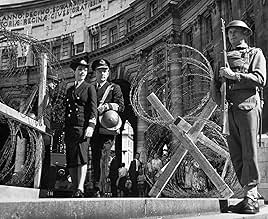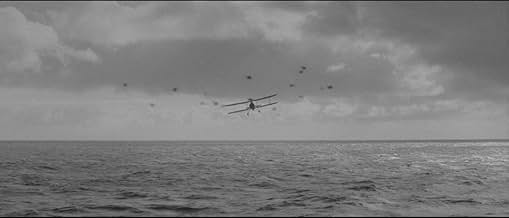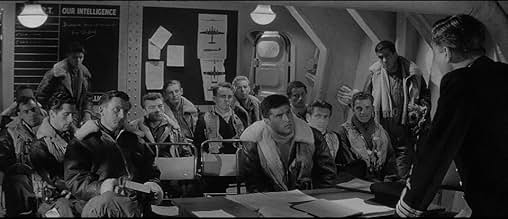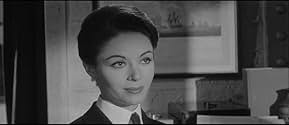NOTE IMDb
7,2/10
8,8 k
MA NOTE
Ajouter une intrigue dans votre langueThe World War II story of the Royal Navy's effort to defeat Nazi Germany's most powerful warship.The World War II story of the Royal Navy's effort to defeat Nazi Germany's most powerful warship.The World War II story of the Royal Navy's effort to defeat Nazi Germany's most powerful warship.
- Réalisation
- Scénario
- Casting principal
- Récompenses
- 2 nominations au total
Carl Möhner
- Kapitän Ernst Lindemann
- (as Carl Mohner)
Jack Gwillim
- Commodore Wilfrid Patterson - HMS King George V
- (as Jack Gwillam)
Avis à la une
The German battleship Bismark was one of the finest warships ever built. She carried 8 15-inch guns and a powerful secondary battery and could make 30 knots. It wasn't one of the biggest or most powerful battleships ever built. The Japanese had the Yamato and Mushashi towards the end of the war, juggernauts with 18-inch cannons. There's a limit to gigantism of course, and in the case of battleships it had to do with whether they could fit physically through the Panama Canal, a concern the Japanese had long put behind them. So the Bismark wasn't the sort of sacred monster that sheer size would make her. But she LOOKED absolutely great. Sleek, well balanced, with her superstructure done the way an architect might have done it, not an engineer. She looked built for speed, and endurance too. For an example of the opposite trend, take a look at Rodney or Nelson. More powerfully armed, with 9 16-inch guns carried in three turrets, all set forward of the superstructure. Man, that is one ugly design. And, more than that, Bismarck's crew were highly trained and she was equipped with one of the world's best optical fire-control systems. It wasn't just luck that sank the Hood and damaged any smaller ships that go too close; it was good shooting. (Her shooting didn't fall off until that final bombardment.) Winston Churchill called her "a masterpiece of naval construction," although not in this movie. She kept large elements of the fleet pinned down at home simply by sitting in her protected port and being available.
I must have seen this movie a dozen times and each time I begin by wondering if I'll be able to sit through it again. (I've got some of the exchanges memorized.) I generally make it, though. It's too good in its own dated way to pass up.
The model work is not bad at all for its time. The reviewer who said this film called for black and white was correct. It looks cold and frightening on the North Atlantic. Almost everything would have been, or at least seemed, gray even if it had been shot in color. The peformances are up to professional standards. More is a different character here from his usual jocular one -- frosty, demanding, and no nonsense. Until finally, overcome with emotion, he breaks down in an understated scene. Dana Wynter, his assistant, spots him and discreetly leaves him alone. She's too beautiful to criticize as an actress. She radiates purity and anima and gently draws More out of his shell. Naismith is a familiar face, as are many of the others. And there is a running gag in this underground bunker where More is plotting the Bismarck's demise. Nobody knows what time it is or, if they know it's 9 o'clock, they don't know if its morning or evening. Even the Germans aboard the Bismarck are lent some humanity by the script writers. The cadets look like earnest fresh-faced kids. The Captain is a practical man, worried about his ship and his crew. Only Karel Stepanek, as Lutjens, belongs in another, much earlier movie, say one made in 1943. He is well out of the frame established in the rest of the film. Stricken with awe when he gets a birthday greeting from You-Know-Who. Some of the dialogue is made up, out of necessity. Who knows what went on on the Bismarck's bridge, especially during that last catastrophic shelling? Back in the bunker, Dana Wynter looks down at the wooden models on her chart where a dozen British warships surround the single Bismarck and pound her to pieces. "I don't feel like cheering," she says. Well, "War is all hell." Maybe that's why human beings seem to need another one every twenty years or so, to remind ourselves.
What a waste of great ships, and of good men, on both sides. And an argument could even be made that Bismarck's sister ship, the Tirpitz, played an even more important part in the war simply by staying put and tying down so many British ships that were needed elsewhere. Our side "wins," of course. Our side almost always wins when we're the side that's funding the movie. A lot of viewers will expectably feel relief when the threat represented by Bismarck is over, but they probably won't feel much like cheering.
I must have seen this movie a dozen times and each time I begin by wondering if I'll be able to sit through it again. (I've got some of the exchanges memorized.) I generally make it, though. It's too good in its own dated way to pass up.
The model work is not bad at all for its time. The reviewer who said this film called for black and white was correct. It looks cold and frightening on the North Atlantic. Almost everything would have been, or at least seemed, gray even if it had been shot in color. The peformances are up to professional standards. More is a different character here from his usual jocular one -- frosty, demanding, and no nonsense. Until finally, overcome with emotion, he breaks down in an understated scene. Dana Wynter, his assistant, spots him and discreetly leaves him alone. She's too beautiful to criticize as an actress. She radiates purity and anima and gently draws More out of his shell. Naismith is a familiar face, as are many of the others. And there is a running gag in this underground bunker where More is plotting the Bismarck's demise. Nobody knows what time it is or, if they know it's 9 o'clock, they don't know if its morning or evening. Even the Germans aboard the Bismarck are lent some humanity by the script writers. The cadets look like earnest fresh-faced kids. The Captain is a practical man, worried about his ship and his crew. Only Karel Stepanek, as Lutjens, belongs in another, much earlier movie, say one made in 1943. He is well out of the frame established in the rest of the film. Stricken with awe when he gets a birthday greeting from You-Know-Who. Some of the dialogue is made up, out of necessity. Who knows what went on on the Bismarck's bridge, especially during that last catastrophic shelling? Back in the bunker, Dana Wynter looks down at the wooden models on her chart where a dozen British warships surround the single Bismarck and pound her to pieces. "I don't feel like cheering," she says. Well, "War is all hell." Maybe that's why human beings seem to need another one every twenty years or so, to remind ourselves.
What a waste of great ships, and of good men, on both sides. And an argument could even be made that Bismarck's sister ship, the Tirpitz, played an even more important part in the war simply by staying put and tying down so many British ships that were needed elsewhere. Our side "wins," of course. Our side almost always wins when we're the side that's funding the movie. A lot of viewers will expectably feel relief when the threat represented by Bismarck is over, but they probably won't feel much like cheering.
Kenneth More plays the severe cold and uncompromising Captain Jonathan Shepard who has lost his wife in an air raid, and whose son is a naval pilot in the warfare against the Bismarck...
'Bismarck' is a super German battleship of World War II that had a short, but spectacular career...
Captain Shepard guides the distinguished campaign from the Admiralty War headquarters in London: The search, the course, the deploy and the destruction of the Bismarck under an archetype that said: 'Getting emotional about things is a peacetime luxury.'
The Bismarck's admiral (Karel Stepanek) is a Nazi officer characterized by emotional instability, presumptuous and overenthusiastic...
Sighted and bombarded by British battleships, the Bismarck is incapacitated and sunk by torpedoes on the morning of May 27, 1941.
Dana Wynter is the likable attractive lady naval officer, fitting in mood and attitude...
In the climax of the film and after the naval epic, Michael Hordern, the Commander-in-Chief of the Home Fleet, turns to his men and says: 'Let's go home, gentlemen!'
This exciting sea battle would have been better on a standard screen than in CinemaScope, as its ships were clearly 'models' using newsreels footage... Nevertheless, the film is an entertaining hunt, with good acting.
Beside the search and eventual sinking of the Bismarck, I would like to mention, that the personal drama of the British sailors increase the intensity of the picture's realism...
'Bismarck' is a super German battleship of World War II that had a short, but spectacular career...
Captain Shepard guides the distinguished campaign from the Admiralty War headquarters in London: The search, the course, the deploy and the destruction of the Bismarck under an archetype that said: 'Getting emotional about things is a peacetime luxury.'
The Bismarck's admiral (Karel Stepanek) is a Nazi officer characterized by emotional instability, presumptuous and overenthusiastic...
Sighted and bombarded by British battleships, the Bismarck is incapacitated and sunk by torpedoes on the morning of May 27, 1941.
Dana Wynter is the likable attractive lady naval officer, fitting in mood and attitude...
In the climax of the film and after the naval epic, Michael Hordern, the Commander-in-Chief of the Home Fleet, turns to his men and says: 'Let's go home, gentlemen!'
This exciting sea battle would have been better on a standard screen than in CinemaScope, as its ships were clearly 'models' using newsreels footage... Nevertheless, the film is an entertaining hunt, with good acting.
Beside the search and eventual sinking of the Bismarck, I would like to mention, that the personal drama of the British sailors increase the intensity of the picture's realism...
This is a little known war time epic movie that should rank with the likes of "Patton". The story is about the grudge match that's spawned from sinking of battleship Hood by the German battleship Bismark. A full blown search for the German battleship by the British navy takes place to hunt down and sink the Bismark. Acting is first class, and although the special effects have something to be desired by today's standard, movie none the less conveys the tension and excitement of what probably was the greatest and the final naval conflict between battleships. In recent years Bob Ballard and the Oceanographic Institute rediscovered the sunken remains of the battleship Bismark which confirmed the ferocity of the fire power that was exchanged in this naval warfare. This movie gets mentioned by movie producers of today when they sight their seminal influence it had on some of their plot lines, which attests to its production value. The sub plot which unfolds between Kenneth Moore and Dana Wynter is also written superbly. A good war time semi documentary that's worth seeing.
The British have made war and historical movies with an unrivaled consistency of quality, and Sink the Bismarck is no exception. The details are meticulous, the casting first-rate (except for a hokey voice-impersonation of Churchill), and the battle sequences marked by accuracy and fine special effects.
This otherwise fine film is marred, however, by the false depiction of one of the major characters, Admiral Lutjens, commander of the Bismarck. In the film, he is stereotyped as the typical Nazi - a Hitler sycophant, careerist and wild-eyed fanatic. This was most certainly not the historical Lutjens, who was by no means a Nazi fanatic. Lutjens was a naval hero from World War I, who served out of duty and dedication, not Nazi conviction. (Lutjens protected Jews under his command, and members of his family were in trouble for their anti-Nazi views.) This is at complete odds with his depiction in Sink the Bismarck, which I find inexcusable, given that the above information was certainly available to the production. In fact, an accurate depiction of Lutjens would have, in my opinion, added interest to the plot.
Nevertheless, Sink the Bismarck is eminently watchable and a fine addition to any war movie collection, if you bear in mind the above caveat.
This otherwise fine film is marred, however, by the false depiction of one of the major characters, Admiral Lutjens, commander of the Bismarck. In the film, he is stereotyped as the typical Nazi - a Hitler sycophant, careerist and wild-eyed fanatic. This was most certainly not the historical Lutjens, who was by no means a Nazi fanatic. Lutjens was a naval hero from World War I, who served out of duty and dedication, not Nazi conviction. (Lutjens protected Jews under his command, and members of his family were in trouble for their anti-Nazi views.) This is at complete odds with his depiction in Sink the Bismarck, which I find inexcusable, given that the above information was certainly available to the production. In fact, an accurate depiction of Lutjens would have, in my opinion, added interest to the plot.
Nevertheless, Sink the Bismarck is eminently watchable and a fine addition to any war movie collection, if you bear in mind the above caveat.
For starters, this picture was thankfully filmed in black and white. This is only appropriate for gray colored ships shooting it out in the North Atlantic. The performers were, for the most part, convincing. The movie got a little risky by using a fictional character (played by Kenneth More) for the lead role, and delving a bit into his personal life. But it didn't get out of hand. The movie takes just the right amount of time in developing and depicting the important events in the eight day life of the Bismarck. I got the feeling that I was actually there and watching these events take place. The movie is essentially accurate, based on accounts I have read in books; including one by the highest ranking German survivor. The depiction of the destruction of the British battle cruiser Hood was not exactly accurate, but I would rank that a minor point. Getting the ship used in the movie to blow up the same way the Hood would probably have been more trouble than it was worth. The bottom line is the ship was destroyed and only three crew members survived.
This movie is an excellent, no-nonsense portrayal of the short and dramatic life of the legendary German battleship Bismarck.
This movie is an excellent, no-nonsense portrayal of the short and dramatic life of the legendary German battleship Bismarck.
Le saviez-vous
- AnecdotesThe Bismarck's crew was made up of just over two thousand men. Following her sinking, only 114 survivors were rescued from the sea, 110 of them by HMS Dorsetshire and the Tribal-class destroyer HMS Maori. The rescue of survivors was called off by the captain of HMS Dorsetshire amid reports that a U-Boat may be in the area.
- GaffesThe characterization of Admiral Gunther Lütjens in this movie is wildly inaccurate. He is shown as a zealot, a fanatic, denying reality until the end. In fact, Lütjens was a thoughtful, even morose figure - some survivors claimed that his tendency for fatalism damaged their morale. Absurdly, on screen the Admiral tells his men to "remember you are Nazis!" Lütjens was not a Nazi (very much the opposite, to the extent that he famously refused to perform the Nazi salute for Hitler before the Bismarck set sail), nor were the vast majority of his officers and crew.
- Citations
[to his assistant Anne Davis, after the battle]
Captain Jonathan Shepard: Take a message: "Request pleasure of the company of Second Officer Anne Davis at dinner."
- Crédits fousOpening credits prologue: LONDON MAY 1941
- ConnexionsEdited from Torpilles sous l'Atlantique (1957)
Meilleurs choix
Connectez-vous pour évaluer et suivre la liste de favoris afin de recevoir des recommandations personnalisées
- How long is Sink the Bismarck!?Alimenté par Alexa
Détails
- Date de sortie
- Pays d’origine
- Langues
- Aussi connu sous le nom de
- ¡Hundan al Bismarck!
- Lieux de tournage
- Société de production
- Voir plus de crédits d'entreprise sur IMDbPro
Box-office
- Budget
- 1 330 000 $US (estimé)
- Durée1 heure 37 minutes
- Couleur
- Mixage
- Rapport de forme
- 2.20 : 1
- 2.35 : 1
Contribuer à cette page
Suggérer une modification ou ajouter du contenu manquant

Lacune principale
By what name was Coulez le Bismarck! (1960) officially released in India in English?
Répondre



































